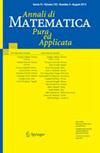伪凸域的分裂类型结果及其 Nebenhülle 评论
IF 1
3区 数学
Q1 MATHEMATICS
引用次数: 0
摘要
在平滑有界伪凸域的背景下,我们给出了接近同一性的双全形映射的一般分裂类型定理(定理 1.4)。作为一种特殊情况,在蠕虫域的背景下,我们基本上重现了 Bracci 等人(Math Z 292:879-893, 2019)的分裂类型结果(定理 1.3)(方法不同)。我们还讨论了虫域的内本许勒的一些性质。本文章由计算机程序翻译,如有差异,请以英文原文为准。
Splitting type results for pseudoconvex domains and remarks on their Nebenhülle
We give a very general splitting type theorem for biholomorphic maps close to identity in the context of smoothly bounded pseudoconvex domains (Theorem 1.4). As a particular case, in the context of worm domains, we essentially reprove the splitting type result (Theorem 1.3) from Bracci et al. (Math Z 292:879–893, 2019) (by a different method). We also discuss some properties of the Nebenhülle of worm domains.
求助全文
通过发布文献求助,成功后即可免费获取论文全文。
去求助
来源期刊
CiteScore
2.10
自引率
10.00%
发文量
99
审稿时长
>12 weeks
期刊介绍:
This journal, the oldest scientific periodical in Italy, was originally edited by Barnaba Tortolini and Francesco Brioschi and has appeared since 1850. Nowadays it is managed by a nonprofit organization, the Fondazione Annali di Matematica Pura ed Applicata, c.o. Dipartimento di Matematica "U. Dini", viale Morgagni 67A, 50134 Firenze, Italy, e-mail annali@math.unifi.it).
A board of Italian university professors governs the Fondazione and appoints the editors of the journal, whose responsibility it is to supervise the refereeing process. The names of governors and editors appear on the front page of each issue. Their addresses appear in the title pages of each issue.

 求助内容:
求助内容: 应助结果提醒方式:
应助结果提醒方式:


